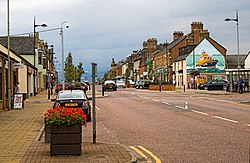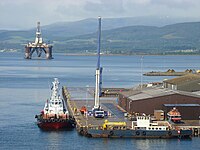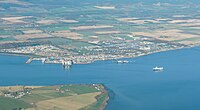Invergordon
| Invergordon | |
| Ross-shire | |
|---|---|
 Invergordon | |
| Location | |
| Grid reference: | NH715685 |
| Location: | 57°41’17"N, 4°9’25"W |
| Data | |
| Population: | 3,890 (est.) |
| Post town: | Invergordon |
| Postcode: | IV18 |
| Dialling code: | 01349 |
| Local Government | |
| Council: | Highland |
| Parliamentary constituency: |
Caithness, Sutherland and Easter Ross |
Invergordon is a port town in Ross-shire, by the coast of the Cromarty Firth, in Easter Ross.
The town escaped the notice of grand history for most of its life. It served well as a major naval basein the early twentieth century. The town though became infamously known for the Invergordon Mutiny of September 1931 in which for two days around 1,000 sailors of the British Atlantic Fleet were in open mutiny over a reduction in rates of pay proposed as a result of the Great Depression.
More recently, the Navy's having left the town, Invergordon became known for the repair of oil rigs which used to be lined up in the Cromarty Firth on which the town is situated. All the parked oil rigs have now been sold to overseas operators and for the first time in many years the Cromarty Firth lies virtually empty. The last one departed for India to be used by Essar Oil in March 2007.
In the 1970s and 1980s nearby Nigg constructed these oil rigs. The yard used for this is now attempting to re-establish itself as a fabricator of large offshore wind turbines. For a number of years Invergordon boasted an aluminium smelter, and still has a grain whisky distillery, the output of which contributes to many blended whiskies. At present the port is visited by many large cruise liners each year, as the deep water port allows disembarkation for coach tours in the northern Scottish Highlands.
Since the 1970s the town has gained the nature of a 'Glasgow colony', since many workers were imported from the Lowlands to work in the oil rig fabrication and aluminium smelting industries. As a result, the residents' accents often show more influence from Glasgow, than the surrounding Easter Ross dialect of Highland English.
A naval base was in use here in the early 20th century, evidence of which remains in the tank farm lying behind the town centre. The tanks were used to contain fuel oil and water for ships of the Royal Navy. The Admiralty Pier, where once warships docked and which is now used for cruise ships in the summer and oil field support vessels through the year.
During the Second World War, when a large flying boat base occupied much of the northerly coast of the Cromarty Firth, a German bomb hit one of the tanks and the fuel oil flowed onto the railway tracks. According to town history, the bomb did not actually explode.
Invergordon Castle
In the 13th century under William the Lion, an earthwork fortress, called Inverbreakie were raised by a Flemish nobleman to whom the King had (it is believed) granted the estate. A tower house was built. In the early 18th century, Sir William Gordon bought the estate. The existing stone tower house on the site was rebuilt. Gordon's work was destroyed by fire in the early 19th century and in 1873 an Elizabethan style mansion house was built on the site, a house incorporating the remaining stonework from the old castle. In 1928 the house was completely demolished
The grounds are now occupied by the golf course. The castle is remembered in Castle Avenue.
Murals
Invergordon is adorned with a series of 17 murals, and calls itself the mural town of the Highlands, imitating the town of Chemainus in British Columbia from which inspiration was taken.
The paintwork created by a selection of artists tells the stories of the local community and the area. This trail is a result of a community project which was initially designed to integrate local community groups. The trail, which was opened by the Princess Royal, now acts as a major tourist draw. Now Invergordon off the wall, the group who facilitated the project, are turning to new media and local people's help to create more quality art work in the area.
Railway
The town is served by Invergordon railway station which lies on the Far North Line, connecting Wick with Inverness.
Outside links
- Invergordon Community Online
- Cromarty Firth Port Authority
- Invergordon Football Club
- Invergordon Off the Wall

